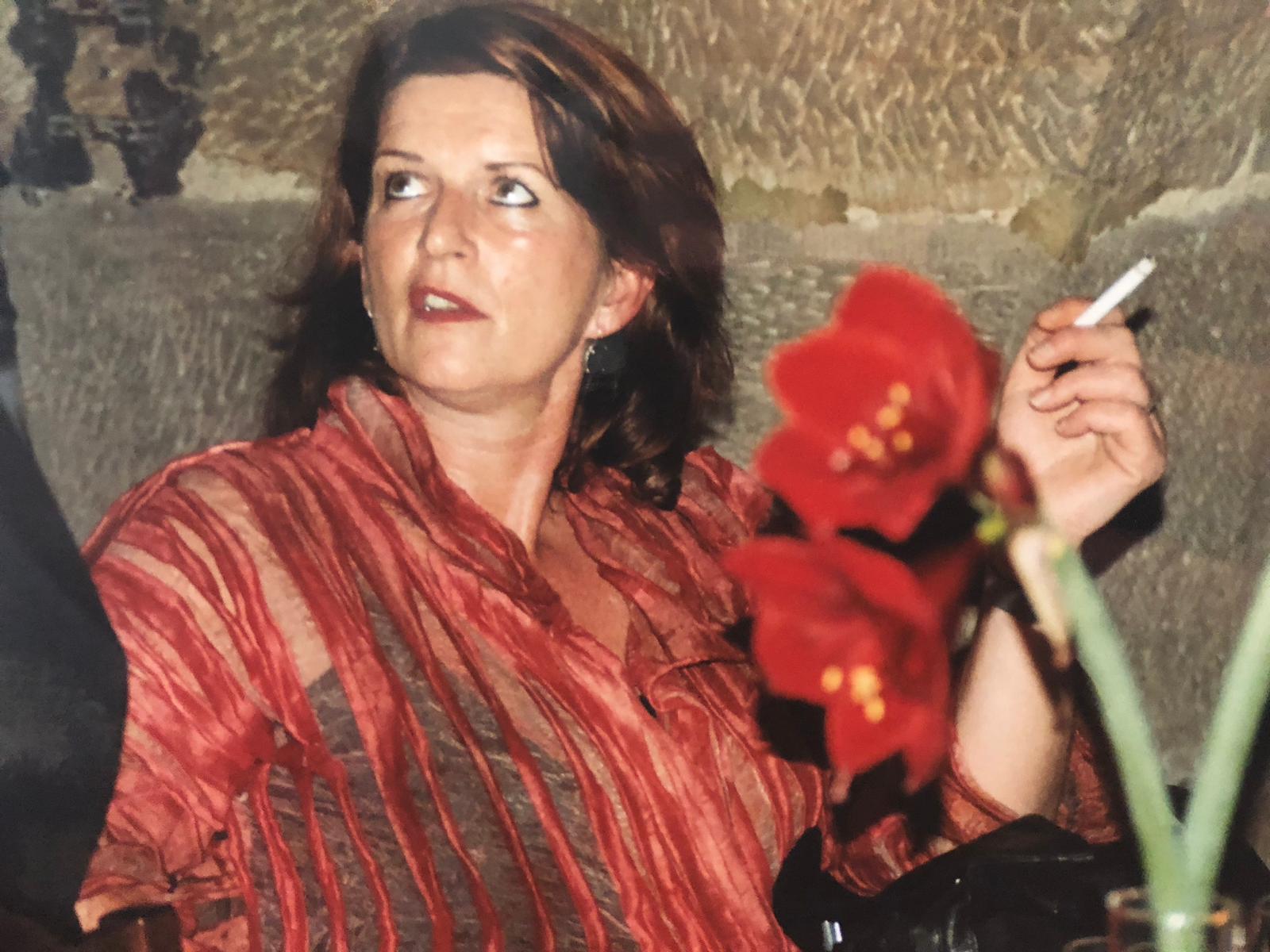This is what it’s like saying goodbye to someone who has chosen to die
I’d never known exactly when someone was going to die – the date, the hour, the minute – until now


We knew Annemie had made the decision to die when we got an invite to say goodbye on our shared WhatsApp group. “The September weekend is still on,” the message read, “but it’s Annemie’s farewell.”
Those words signalled that her dying day was set, diarised like a hospital appointment. My heart pounded. We’d already had this weekend planned, but what did it mean now? A party? A funeral with the person right there with us?
I was sitting at the hairdressers, and how frivolous it seemed. My head covered in silver foil, bleach burning my scalp. A flurry of emojis followed the text: hearts, stars, a sun, but no more words. I sent a tiny symbol, a breaking heart.
A few days later and our family was sitting in the car, making the eight-hour drive from London to Spaubeek in the Netherlands, where the Noten family live. This was a familiar routine, one taken many times over the past 25 years since Annemie’s daughter Floor and I met aged five, at school in Market Harborough. When they left, years later, they didn’t depart from our lives.
A heavy ball of anxiety lodged in my chest. I’d never known exactly when someone was going to die – the date, the hour, the minute – until now. I needed to know the rules, and my sister wanted to know how she should act. “Just as we always do,” my dad said, clutching the steering wheel a little tighter than usual.
“This is a gathering of friends, like always,” Dad told us, once we’d boarded the Eurotunnel. It felt dark and oppressive; I couldn’t wait to catch a glimpse of daylight on the other side. Tears rolled down Mum’s cheeks. We agreed it was best to cry now, before we greeted Annemie.
Annemie and her husband Roel’s house could’ve been on a Dutch postcard with its steep, triangular roof, red bricks and oval wooden front door with lattice panels arched over the top. My sister squeezed my hand as Mum rang the doorbell. Floor opened the door and enveloped us in a hug. I could feel her two young sons tugging at the legs of my trousers. “I’m so glad you’re here,” she said, with a hint of relief.
The Notens were around the table, big enough to seat 20. Just last year, we were in exactly that spot for Roel’s 60th birthday. Annemie was in her electric wheelchair, excruciating pain etched onto her face, ankles so swollen that her taut skin was raw and red. She bit down on a cloth as waves of agony jolted through her. Her decision was there right in front us, crystal clear – she was ready to leave that body. Until then, we weren’t to fuss.
We could feel her pain, but we weren’t to acknowledge it. Annemie never wanted our pity. She wanted us to get on with it. Don’t make a big deal, because it isn’t one. Don’t make a drama out of someone else’s reality. Instead, we passed each other chips, bitterballen (meatballs) and mayo.
I glanced at the portrait of Annemie hanging above Floor’s head. Annemie had got it commissioned to symbolise her love for Roel. Butterflies fluttered around her. Annemie loved butterflies, the kind she still got in her stomach when she looked at Roel, when they kissed, touched, had sex. I knew this because she’d told us, many times before.
Annemie had never let MS define her. For more than 20 years the disease seeped through her veins. Now 59, she’d never know what 60 felt like. The immobility wasn’t a problem, her confinement to a wheelchair never inhibited her happiness. Her world was small, but her family was in it – all that had ever mattered.
When Annemie had been diagnosed, doctors warned that it would likely rip their relationship apart, like it had others before. “Not us,” Roel had maintained, even as he morphed into Annemie’s carer. “We’re married, it’s for life. This is what you do.”
That evening, we heard snippets of the heart-wrenching conversations from the previous week. “I cannot do this any longer,” she’d said. “I can’t go back to hospital. I’m scared, afraid, but I think I want to die.”
So, the process of euthanasia was started with her GP. A legal process in the Netherlands, it has three strict criteria: the illness is unbearable, untreatable and you are fully, consciously, aware of the decision.
The next morning, my husband James arrived. I was making cakes with the kids, like we were preparing for a strange kind of birthday party. I guess we sort of were. It was to be a celebration of Annemie’s escape from the body that had been rebelling against her.
We were each to take a piece of clothing from Annemie’s wardrobe, on the promise we’d love it as it became our own. I picked a cropped cardigan, black, red and pink with a little collar and flowers on the cuffs. At first, it felt jarring, trying on a dead person’s clothes as she sat right in front of us.
Soon, select guests arrived, including Annemie’s sister, Geraldine. In the kitchen, Roel and James prepped seafood. Roel served up platters of oysters, herring, prawns, salmon; wine was poured into glasses like bowls.
Then he stood at the head of the table, clinking his glass as if he were about to deliver a toast. “I loved Annemie from the moment I saw her,” he stated. He was 17, she was 15, sitting at the bar her parents owned. He walked in and knew at that moment he would marry her. “I kissed her that night,” Roel said. “I knew she loved me, too.”
As he talked, Annemie smoked a cigarette in her wheelchair. I remembered how I saw her once, coolly, roll a cigarette with one hand as she drove. How could those hands belong to the same person?
Then we got tipsy, the kind of drunk you get at a party. We told all the tales we’d recounted many times. This time, our stories had renewed significance. This was the last time Annemie – the matriarch, the centre of our group – would hear them.
Her agony was evident, so visceral we could feel it. There was a resignation too. We knew she wanted us there, she just couldn’t contribute. I’d studied euthanasia in my A-level religious studies, and passionately believed that everyone should be able to die if they chose. It was academic theory then, and now I was faced with its reality.
I’d read stories of those with degenerative diseases who argued that UK law needs to reform to catch up with what is ethical, humane – especially now Covid has restricted travel for those who want to fly to Dignitas in Switzerland. Even then, families travelling with them risk arrest. I wondered how it might be reshaping funerals and the grieving process, too.
I think of the people close to me who’ve died: Gran, Grandma, Auntie Heather. Their deaths hadn’t felt like a celebration of life, they had been talked about in shameful hushed tones. My husband’s sister, Kate, who died from cancer at 32, just a few weeks before I met him.
I think of how we’d avoided talking about her in the early days of our relationship. I think of Annemie announcing her need for death, giving out the items of her life like historic mementoes. She'd had no choice about what happened to her body, this was her taking back some power. I’d want that, too.
The next morning, we said goodbye. Annemie was in bed in the living room. On a wooden table next to her head was a bell jar of taxidermy butterflies. I love you, I said as I kissed her cheek. There was nothing left to say. I didn’t cry until I got in the car.
Annemie died from a lethal concoction of drugs injected into her veins at midday on 24 October 2018. We were notified via our WhatsApp chat. For once, there was no shock or surprise.
“She’s our hero,” Roel wrote, alongside a final picture of everyone together. Annemie smiling as much as she could; her children, their babies, her husband, sister, and mother around her. The butterfly portrait above their heads. A week and a half later, Annemie’s body lay in a white coffin, covered in butterflies drawn in crayon by the children. She looked peaceful.
It wasn’t as sad as other funerals I’ve been to. We’d grieved with her and now she was free. Annemie had talked of bodies, life, sex – and she also made me rethink death. There was no stigma, no shame.
I looked at the children holding paper butterflies in their hands. They’d been told that was what their Oma was metamorphosing into. Two-year-old Ruby gestured towards the head of the coffin, puckering her lips, her mother Marcela scooped her up in her arms so she could lean over, her lips grazing her Oma’s cheeks.
If you have been affected by this article, you can contact the following organisations for support:
mind.org.uk
beateatingdisorders.org.uk
nhs.uk/livewell/mentalhealth
Mentalhealth.org.uk
samaritans.org
Join our commenting forum
Join thought-provoking conversations, follow other Independent readers and see their replies
Comments





Bookmark popover
Removed from bookmarks